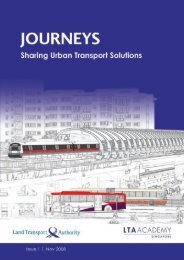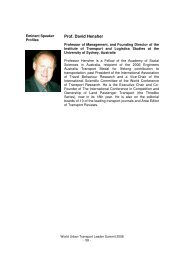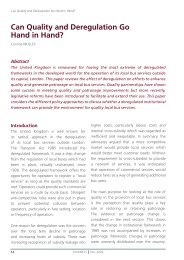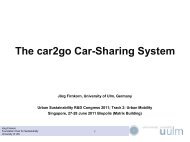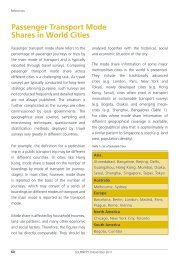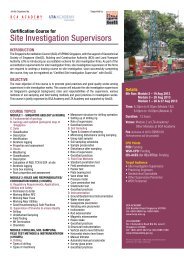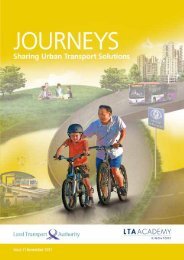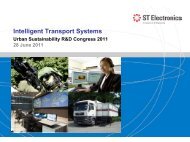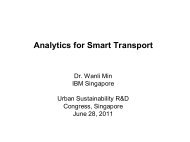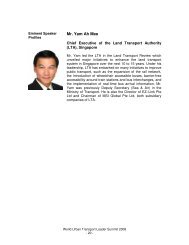Evolution of E-payments in Public Transport—Singapore's ... - IBM
Evolution of E-payments in Public Transport—Singapore's ... - IBM
Evolution of E-payments in Public Transport—Singapore's ... - IBM
You also want an ePaper? Increase the reach of your titles
YUMPU automatically turns print PDFs into web optimized ePapers that Google loves.
<strong>Evolution</strong> <strong>of</strong> E-<strong>payments</strong> <strong>in</strong> <strong>Public</strong> Transport—S<strong>in</strong>gapore’s Experience<br />
For buses, the payment system under ITS<br />
rema<strong>in</strong>ed largely manual. The commuter would<br />
<strong>in</strong>sert his farecard <strong>in</strong>to a bus validator (Figure 2)<br />
and choose the appropriate fare, after which<br />
his farecard would be returned together with a<br />
ticket for his ride.<br />
Figure 2: A bus validator<br />
Initially, the farecards could only be topped-up<br />
us<strong>in</strong>g cash at TransitL<strong>in</strong>k <strong>of</strong>fices <strong>in</strong> rail stations.<br />
This top-up service was later extended to<br />
bus <strong>in</strong>terchanges. Self-service mach<strong>in</strong>es were<br />
subsequently <strong>in</strong>troduced to allow top-up<br />
through EFTPOS (Electronic Fund Transfer at<br />
Po<strong>in</strong>t <strong>of</strong> Sale).<br />
The convenience <strong>of</strong> the farecard, compared to<br />
the hassle <strong>of</strong> carry<strong>in</strong>g sufficient cash, drove a<br />
progressive conversion to farecards. By the<br />
late 1990s, farecards were used for 85% <strong>of</strong><br />
public transport trips. The reduction <strong>in</strong> cash<br />
management translated to a significant sav<strong>in</strong>g<br />
<strong>of</strong> about 7% <strong>in</strong> operat<strong>in</strong>g costs for the public<br />
transport operators.<br />
54<br />
JOURNEYS Nov 2009<br />
Introduc<strong>in</strong>g Contactless<br />
Smart Cards<br />
Contactless smart cards made their appearance<br />
<strong>in</strong> public transport <strong>in</strong> Europe and Japan <strong>in</strong><br />
the early 1990s. Due to the need to enhance<br />
S<strong>in</strong>gapore’s ticket<strong>in</strong>g system, the Land<br />
Transport Autority (LTA) undertook several<br />
years <strong>of</strong> studies and field trials and decided<br />
to use the contactless smart card as the new<br />
ticket medium even though the underly<strong>in</strong>g<br />
technology, <strong>in</strong>clud<strong>in</strong>g the card itself, was largely<br />
proprietary.<br />
In 2002, after three years <strong>of</strong> development, LTA<br />
rolled out the Enhanced Integrated Fare System<br />
(EIFS). The new system used contactless smart<br />
cards, known as ez-l<strong>in</strong>k cards, to replace the<br />
magnetic farecards. Figure 3 shows a commuter<br />
tapp<strong>in</strong>g the contactless ez-l<strong>in</strong>k card aga<strong>in</strong>st the<br />
reader at a fare gate.<br />
Figure 3: An ez-l<strong>in</strong>k card be<strong>in</strong>g used at a rail station<br />
Enhancements under EIFS<br />
EIFS <strong>of</strong>fered several enhancements over the ITS:<br />
(i) 1¢ <strong>in</strong>crements <strong>in</strong>stead <strong>of</strong> 5¢ <strong>in</strong>crements, to<br />
provide greater flexibility for fare sett<strong>in</strong>g<br />
and adjustments;<br />
(ii) An extended fare structure compared to<br />
the magnetic card. This enhancement was<br />
necessary for the ticket<strong>in</strong>g system to cater<br />
to an expanded rail network;



